The Power Dynamics within BJP
As a party, the Bharatiya Janata Party (BJP) has always been known for its collective decision-making process. However, over the past few years, the dynamics within the party seem to have shifted significantly. The rise of Narendra Modi and Amit Shah to the helm of the party has led to a concentration of power that is unprecedented in the BJP's history. The command structure appears to be more top-down now than ever before, raising questions about the party's internal democracy.
Modi-Shah Duo: A Dominant Force
The partnership of Narendra Modi and Amit Shah has proven to be a potent combination for the BJP. Together, they have steered the party to massive electoral victories. However, their dominant position within the party has also led to concerns about the sidelining of other senior leaders and the centralization of power. It is hard to ignore the fact that the two leaders have a level of control and influence within the party that is unmatched by anyone else.
The BJP’s Transition under Modi and Shah
Ever since Narendra Modi became the Prime Minister and Amit Shah the party President, there has been a marked change in how the BJP operates. The party that once prided itself on being a 'party with a difference' now seems to be more synonymous with the Modi-Shah duo. The duo's influence permeates every aspect of the party, from policy decisions to candidate selection, leading to a BJP that is markedly different from its previous avatar.
Impact on Internal Democracy
One of the primary concerns raised by the domination of Modi and Shah is its impact on the party's internal democracy. The centralization of power has led to a dilution of the collective decision-making process, which was once a defining characteristic of the BJP. This has led to discontent among some sections within the party, who feel that their voices are no longer being heard.
Amit Shah: The Master Strategist
While Modi is undoubtedly the face of the BJP, it is Amit Shah who is often credited with being the brains behind the party's electoral success. His strategies and meticulous planning have been instrumental in the BJP's victories. However, his dominant role within the party also means that he holds a significant amount of power, leading to questions about the balance of power within the BJP.
The Role of the RSS
The Rashtriya Swayamsevak Sangh (RSS), the ideological parent of the BJP, has always had a significant influence on the party. However, under the Modi-Shah regime, the relationship between the BJP and the RSS has become more complex. While the RSS continues to have a say in the party's decisions, the dominant position of Modi and Shah has led to a shift in the power dynamics.
The Future of the BJP
The BJP under Modi and Shah has achieved unprecedented success. However, the centralization of power raises questions about the party's future. Will the BJP continue to be dominated by the Modi-Shah duo, or will it return to its roots of collective decision-making? The answer to this question will significantly shape the future trajectory of the BJP.
Conclusion: A Shift in Political Dynamics
Undeniably, the BJP has undergone a significant transformation under the leadership of Narendra Modi and Amit Shah. The duo's dominance has led to a shift in the party's power dynamics, raising questions about its impact on the BJP's internal democracy and its relationship with the RSS. While the BJP has achieved spectacular electoral success under their leadership, the centralization of power poses challenges that the party will need to address in the future.





